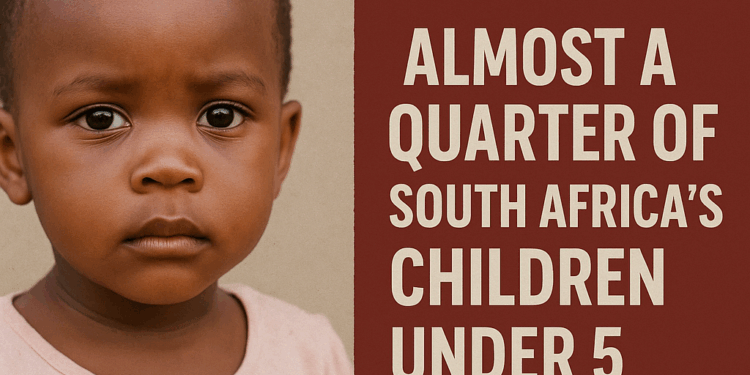
There are tall children and short children — and then there are stunted children. Stunting is not the same as being short. It is a clinical sign of chronic under-nutrition that begins before birth, slows mental and physical development, and increases vulnerability to disease across a lifetime. In South Africa today, almost one in four children under five shows evidence of stunting. That figure is not a statistic to shrug off — it is a national emergency in slow motion.
This article sets out what stunting is, why it happens, who is most at risk, and what works to prevent it — focusing on the first 1,000 days of life (from conception to a child’s second birthday), the window when interventions have the greatest effect.
What stunting means — and why it matters
Stunting is defined as a height-for-age measurement that falls more than two standard deviations below the WHO median. Unlike temporary growth faltering, stunting reflects a long-standing nutritional deficit. Beyond reduced stature, stunted children commonly experience delayed cognitive development, poorer school attainment, and long-term health problems such as higher risk of chronic disease. Stunted adults tend to have reduced economic productivity — perpetuating cycles of poverty and malnutrition.
When stunting begins: the first 1,000 days
The problem usually starts in utero. Maternal undernutrition, adolescent pregnancy, chronic illness and constrained access to care all threaten foetal growth. After birth, breast milk is the ideal sole food for the first six months, but after that nutritious complementary foods — cereals, vegetables, fruit and protein — must be introduced. When complementary feeding is inadequate, stunting becomes entrenched and often irreversible.
A 2024 review in the National Library of Medicine (“Preventing Stunting in South African Children Under 5”; Wand et al.) identified maternal anthropometry (underweight or height <160 cm), low education, absence of medical insurance, marital status and low socioeconomic status as key risk factors in South Africa. The study also showed that, despite improvements between 2008 and 2017, South Africa still ranks among countries with the highest stunting prevalence — and is behind the UNICEF target of a 40% reduction in stunting by 2025.
Who is at risk
Risk is concentrated where poverty, food insecurity and limited maternal health overlap. Teenage mothers, households with low income, and families lacking access to clean water, sanitation and healthcare face the greatest odds that a child will be born small and remain small. Chronic conditions, HIV exposure, and maternal undernutrition compound the problem.
Prevention: practical, proven and urgent
Not every case is preventable, but many are avoidable when action focuses on the right period and the right mix of interventions:
-
Support maternal nutrition before and during pregnancy to protect foetal growth.
-
Promote exclusive breastfeeding for the first six months and continued breastfeeding with nutrient-rich complementary foods thereafter.
-
Introduce nutrient-dense complementary foods from six months, including fortified and diverse family foods.
-
Maintain hygiene and safe water to reduce infections that undermine nutrient uptake.
-
Offer caregiver support and education so families can adopt feeding practices that sustain growth.
-
Screen and refer for clinical conditions that worsen malnutrition.
One specific, evidence-aligned tool is LNS-MQ (Medium-Quantity Lipid-Based Nutrient Supplement) — a peanut-based paste formulated to provide concentrated micronutrients and energy for children aged six to 23 months. When used as part of programmes that protect and promote breastfeeding and diversify complementary feeding, LNS-MQ supports healthy growth in the crucial early months.
Programmes, gaps and the role of partnerships
Government and NGO programmes exist, but many initiatives fall short because they lack scale, fail to prioritise the first 1,000 days, or do not reach the most vulnerable caregivers. That gap is the rationale behind “Raise A Life. Raise A Nation.”, a Compact Food Solutions campaign targeting the early life window with WHO/UNICEF-aligned nutrition products and community delivery through accredited NGO partners.
Compact Food Solutions emphasises evidence-based, scalable interventions: local manufacture (Cape Town), WHO/UNICEF-aligned LNS-MQ, adherence to breastfeeding first principles, robust quality and traceability, and transparent reporting on units delivered and cohorts reached. The company partners exclusively with accredited NGOs to ensure nutrition reaches the children who need it most.
Short- and long-term consequences if we fail
Left unchecked, stunting reduces national human capital and perpetuates inequality. Impaired cognition and school performance translate into lost lifetime earnings for individuals and a measurable drag on national productivity. The cost is not only personal — it is economic and social.
What you can do today
-
Learn the warning signs and ask about growth charts at clinic visits.
-
Support maternal and caregiver nutrition programmes in your community.
-
Back organisations prioritising the first 1,000 days — both financially and through advocacy.
-
Share accurate information about complementary feeding and hygiene with families you know.
A closing imperative
Stunting isn’t normal — and it needn’t be tolerated. Intervening early is the single most effective way to protect a child’s future. If South Africa truly wants to maximise its human potential, we must treat the first 1,000 days as the national priority it is: fund programmes that work, deliver nutrient-rich supplements where needed, promote breastfeeding, and ensure every mother and child has the environment they deserve for healthy growth.
Find out more and support the campaign: https://raisealife.co.za



































